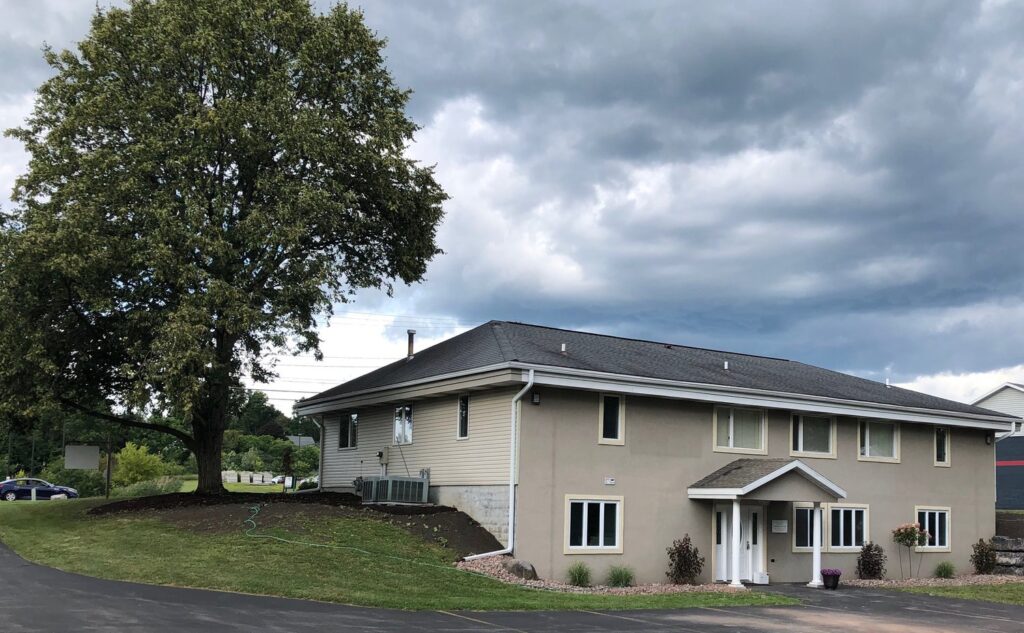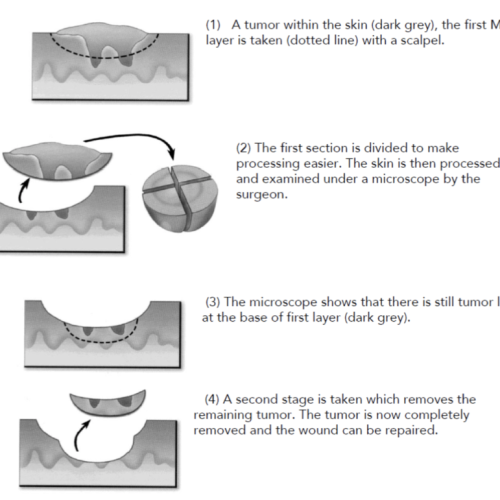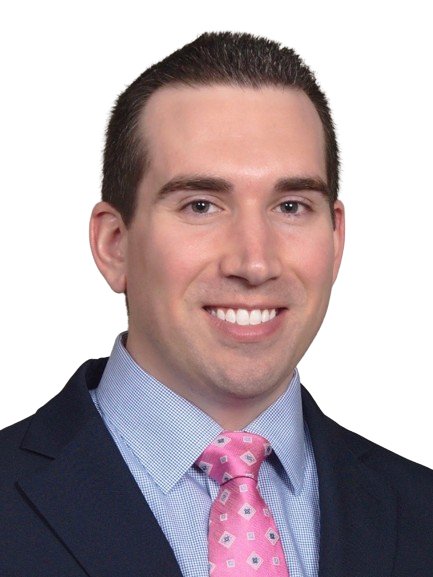Mohs Surgery
Mohs Micrographic Surgery

Our Syracuse location for Mohs Surgery
Mohs Micrographic surgery is a specialized, highly effective technique for the removal of skin cancer. The procedure was developed in the 1930’s by Dr. Frederic Mohs at the University of Wisconsin and is now practiced throughout the world. Skin cancers grow like icebergs; there is often more below the surface than can be seen on top. If only the visible tumor is removed, microscopic cancer cells can get left behind. Under local anesthesia, layers of tissue are removed and examined under a microscope at our onsite laboratory. This process is repeated until all the cancer and its “roots” are removed and only normal tissue remains.
Using this technique, 100% of the surgical margin can be checked. This enables us to remove the least amount of normal tissue to remove those residual microscopic cancer cells. Due to the methodical manner in which tissue is removed and examined, Mohs surgery has been recognized as the skin cancer treatment with the highest reported cure rate of 99% for most tumors.
Advantages of the Mohs Surgical Procedure
Since Mohs surgery requires highly trained personnel, and can be time consuming, it is reserved only for certain cases. The four most common indications for using the Mohs technique are:
1) when the tumor is located on a structure that is so important that one wishes to remove only the diseased tissue and preserve as much of the normal skin as possible (face, ear, hand, etc);
2) when the cancer has been previously treated and has come back (recurred);
3) when the margin or extent of the tumor cannot be identified;
4) when the tumor occurs in an area of the body where it is not effectively curable with other methods.

Advantages of Mohs Surgery in Syracuse
Some skin cancers can be deceptively large – far more extensive under the skin than they appear to be from the surface. These cancers may have “roots” in the skin, or along blood vessels, nerves, or cartilage. Skin cancers that have recurred following previous treatment may send out extensions deep under the scar tissue that has formed at the site. Mohs surgery is specifically designed to remove these cancers by tracking and removing these cancerous “roots.”
For this reason, prior to Mohs surgery, it is impossible to predict precisely how much skin will have to be removed. The final surgical defect could be only slightly larger than the initial skin cancer, but occasionally the removal of the deep “roots” of a skin cancer results in a sizeable defect. The patient should bear in mind; however, that Mohs surgery removes only the cancerous tissue, while the normal tissue is spared.
Special Qualifications of a Fellowship-trained Mohs Surgeon
As a Fellowship-trained Mohs surgeon, I have obtained the highest possible level of education and training available for the treatment of skin cancer. I have specialized skills in dermatology, dermatologic surgery, dermatopathology, and Mohs surgery. After 4 years of dermatology, I did an additional year of fellowship where I completed thousands of Mohs surgery cases to date. I also was trained to perform a wide breadth of surgical reconstructions — from simple side to side closures to large and complicated multi-step repairs. I am a member of the American College of Mohs Surgery because of this advanced training.
Anthony J. Chiaravalloti, MD

Insurance Coverage for Mohs Surgery
Most insurance policies cover the costs of Mohs surgery and the reconstruction of the resultant surgical area. Please contact your insurance carrier directly for the most current payment information relative to this surgery. Our billing department may be able to assist you with the codes for the surgery.
What to Expect
Days prior to surgery:
I recommend that all new patients get a pre-operative consultation, which helps minimize confusion and misconceptions about surgery. If you choose not to have a consultation, we recommend you take a photograph of the site with a smart phone/tablet, if one is available to you, to have for the day of surgery. During this short office visit we will:
Discuss the type and size of your tumor
Take pictures and identify the exact site of your cancer
Assess your current medications and surgical risk
Review the procedure and aftercare
Review expectations for the day of surgery, including the likely surgical reconstruction, wound care and bandaging, and activity modification.
Please do not schedule surgery near to a vacation or a time when you will not be available for us to see you back for follow up.
You will continue all medications, including blood-thinners. You will be asked to abstain from alcohol 3 days prior to and for 3 days after surgery. If possible, reduction or cessation of smoking will lead to a better surgical outcome. Avoiding alcohol for 4 days prior to surgery also helps to reduce bleeding. Please inform us if you are taking vitamin E, gingko, garlic, ginseng, ginger, ephedra or other nutritional supplements as these can sometimes cause an increased chance of bleeding after surgery and should be stopped.
The Tumor
Determining the accurate site of the tumor is paramount. We need to agree on the EXACT location of your biopsy in order to proceed with surgery. We will do this during the preoperative consultation. Because the tumor can change in size and shape after a biopsy, I recommend that you take a picture of the biopsy site at the time you and your provider select Mohs surgery as the treatment option.
Day of Surgery
Having someone accompany you, and be able to drive you to and from your surgery is not required, but recommended — we will discuss this at your preoperative consultation.
If it can be avoided, please try not to bring children to the office
Shower and have a full meal prior to arriving (breakfast or lunch depending on appt time).
Wear loose and comfortable preferably not white, layered clothing.
Women should not wear makeup or jewelry.
Men should shave as appropriate around the tumor.
Plan on being at the office for at least 3-4 hours
You will be greeted and brought back to one of our Mohs surgical rooms. You will likely spend the most of your visit in the surgical room. Snacks, beverages and bathrooms will be available.
Mohs surgery is done in stages and there is a lot of “behind the scenes” work with your tissue in our onsite lab. There will be some downtime, and you are welcome to bring paperwork, I-pads, books and magazines as you like.
Length of Surgery
Every effort will be made to make your day as efficient as possible. However, due to the surgical nature of the work, things can be unpredictable. Although some skin cancers are removed in one stage, the average tumor requires two or three stages for removal, and some require several more. The total time of your visit will depend on how many stages or times this process must be repeated. If your skin cancer should require more than one stage, try not to get discouraged. The intent is to remove the entire skin cancer, and to preserve any uninvolved normal skin. To achieve these goals, the tissue must be removed in very small, conservative layers. Most patients will be done within 3-4 hours and in many cases, less than that. Plan on being here at least ½ the day. Do not make any plans after your surgery, you should go home and rest.
Options for Post-Surgical Reconstruction
We will explain all the methods of closure with you that we think will give the best result.
Our skin has a remarkable ability to heal. Sometimes a wound is allowed to heal in by itself without stitches. This can take 4-12 weeks and in the right area, can lead to an excellent cosmetic result.
The next simplest way of closing skin is stitching it side-to-side in a straight or curved line. If the wound left by the surgery is closed with stitches, they are typically dissolvable. If the skin will not close side-to-side, we may need to do either a graft or a skin flap.
A flap borrows adjacent skin and slides it over to fill the wound.
A graft is a piece of skin removed from a site away from the wound, usually from around the ear or above the collarbone and uses it to cover the wound like a patch.
Occasionally the wounds are in a location or of a size that will necessitate referral to a plastic surgeon or eye surgeon for repair. We typically coordinate this for the following day.
Once wounds are healed, the scar that is left will continue to heal and develop over the next 6 – 12 months.
Mohs Surgery Recovery in Syracuse
Wound Healing, Scarring, and Scar Revision
As with all forms of surgery, a scar will remain after the skin cancer is removed and the surgical area has completely healed. Mohs micrographic surgery, however, will leave one of the smallest possible surgical defects and resultant scars. Scars do have the ability, through the body’s own natural healing properties, to remodel and improve in appearance for a six to twelve month period. There are also many other techniques available for enhancement of the surgical area following skin cancer surgery. Depressed or indented scars may be elevated. Likewise, a raised or roughened scar may be smoothed, using dermabrasion techniques. Skin flaps and grafts also may require a subsequent “touch up” procedure, to further improve their appearance.
Potential Complications Associated With Mohs Surgery
Patients should understand that there is not an absolute guarantee that any given procedure will be totally free of complications or adverse reactions. Mohs surgery is no exception. During surgery, tiny nerve endings are cut, which may produce a temporary or permanent numbness in and around the surgical area. If a large tumor is removed or extensive surgery is required, occasionally a nerve to muscles may be cut, resulting in a temporary or permanent weakness in a portion of the face. This is, however, an unusual complication. The surgical area may remain tender for several weeks or months after surgery, especially if large amounts of tissue were removed. Rarely, some patient experience intermittent itching or shooting pain in the surgical area. In addition, the skin grafts and flaps used to cover surgical areas may not fully survive, requiring additional procedures.
The Days Following Surgery
You will be given specific wound care instructions which will all be written down.
You will be given the necessary initial bandaging supplies to take care of your surgical site.
Most patients do not complain of significant pain. If there is some discomfort, Tylenol is usually all that is required for relief.
Often times patients will have “black and blue” marks and swelling around the site of surgery. This reaction is particularly frequent and exuberant around the eyes. This normal reaction usually gets worse for the first three or four days after surgery, and then slowly begins to improve.
In most cases dissolvable sutures will be used, and often there will be no required follow up visit.
For larger defects and repairs, you will likely receive a few brief post-operative checks to monitor your progress, address any concerns and ensure that you receive the best possible outcome.
If any questions or post-operative issues arise, you may contact my office. I, or one of my team members will be available to assist you.
After hours emergency coverage is available.
After your Mohs surgery, you will be directed to follow-up with your primary dermatologist for continued skin checks. There is a 50% chance you will have a second skin cancer within five years of your first so this close follow-up is essential. Thank you for putting your trust in me. I look forward to taking care of you!
Mohs Surgeon in Syracuse
We are proud to offer the highest quality of care to our patients. The Reflections Dermatology staff is dedicated to providing the most comprehensive and innovative medical, surgical, and cosmetic dermatology available. Dr. Anthony Chiaravalloti specializes in Mohs micrographic surgery and reconstructive surgery.
Our new state of the art surgical center for skin cancer surgeries is located at our Syracuse office. Please contact us today to learn more.

